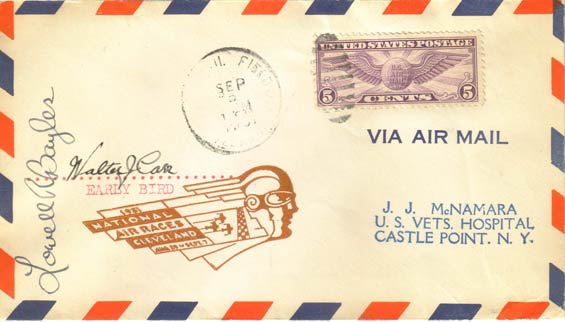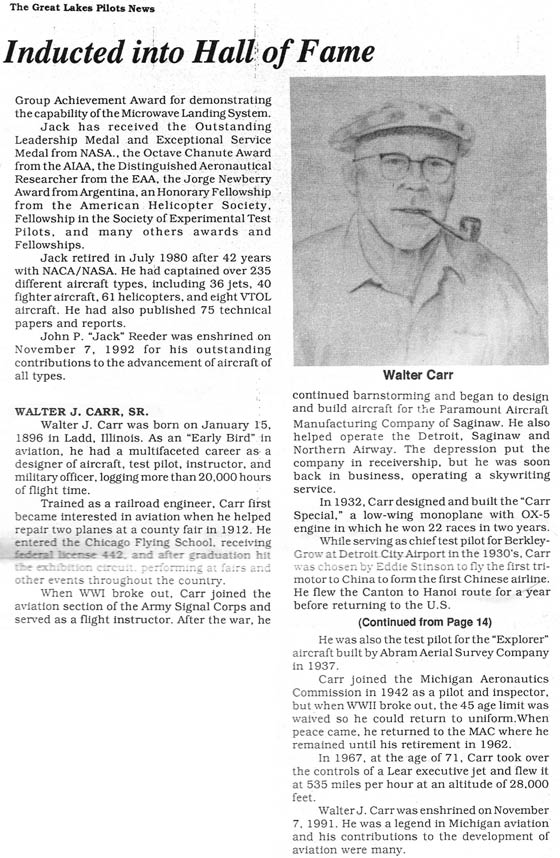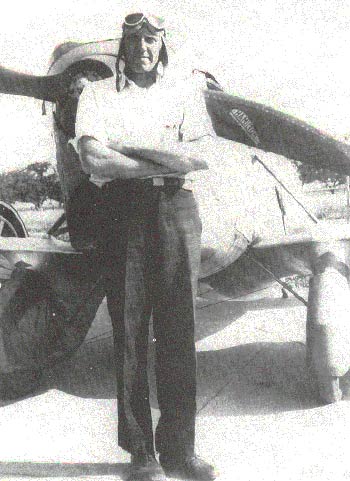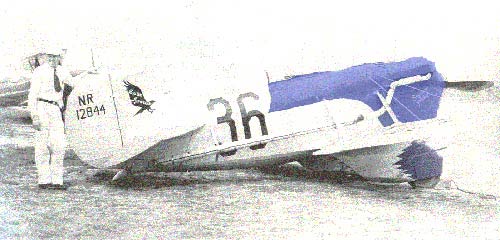|
"Boy what a town!!! I was thirsty!!!
Some airport."
That's what Walter J. Carr wrote in the Remarks column of
the Davis-Monthan Airfield Register upon landing on August
24, 1931. Born January 15, 1896, Carr was 35 years
old when he visited Tucson solo in his Cessna, NC8416.
At this landing he was based in Detroit,
MI. He was eastbound from Los Angeles, CA to Cleveland, OH.
He was undoubtedly on his way to the National Air Races,
which were held in Cleveland from August 29 to September
7 in 1931. He competed there in Event No. 36A, "Speed and
Efficiency Contest for Single Motored Planes." He took second
place flying his Cessna with a Warner engine and won $450.
He probably had this in
his airplane with him.
He had considerable flying experience before he visits us
in Tucson. He soloed on June 15, 1914 in a Curtiss Pusher.
This qualified him for the Early Birds fraternity. He barnstormed
around Michigan and surrounding states before WWI. He gave
fireworks exhibitons with a Kirkham-motored Curtiss Pusher.
When The Great War broke out, he joined the Aviation Section
of the U.S. Army Signal Corps and taught military pilots
to fly. After discharge in January 1919, he continued to
barnstorm from 1920-1927. During this period (1922) he organized
the first aerial police unit in Florida. In that same year
he located a lost motor caravan in the Florida Everglades,
missing for nine days without food or fuel. He found them,
dropped food, then returned and landed with fuel, returning
to Miami with two members of the caravan who were stricken
with fever.
In the early 1920s he designed and built at least two personal
aircraft. One, built in 1919, was a 3-place cabin biplane
pusher powered by an OX-5 engine. The other was the "Maiden
Saginaw", a 3-place cabin monoplane with cantilever wings
(1924). He helped found the Paramount Aviation Company in Saginaw,
MI in 1928. At that time he was also manager of the Saginaw
Airport.
His visit to Tucson introduces him to us early in his competitive
flying career. Besides the 1931 National Air Races, which
brought him to Tucson, he had participated in the 1930 National
Air Tour and placed 15th flying a 165HP Wright-powered Cabinaire. Below, courtesy of site visitor Jeff Staines, a souvenir of the 1931 Air Races in the form of a U.S. postal cachet signed by Carr and stamped with the handsome official race logo. Carr signed it as an Early Bird. Thompson Trophy winner Lowell Bayles (not a Register pilot) also signed.
1931 National Air Races U.S. Postal Cachet, September, 1931 (Source: Staines)
 |
Now comes the 1932 National Air Races in Cleveland. During
1931-32 Carr built another aircraft, especially
for this race, named variously the "Carr Special", "Saginaw
Junior", "Carr Racer" or "Blackhawk". Image, below, from
reference in the left column, is of the "Carr Special" with
Carr at rear. It was OX-5 powered.
At the 1932 race, he entered,
but did not finish, Event No. 4
"Free-for-All" (he pulled out voluntarily after
being lapped by all but one of the other racers). He also
entered Event No. 34 "Precision Landing Contest" but placed
9th out of the money. This ended his efforts at National
Air Racing. He entered a few local races with his airplane,
but Carr and his racer were never major contenders in the
air racing scene of the mid-1930s.
The image above was taken after
the airplane was modified for smoke writing (long exhaust
pipe) late in 1933. "Carr
Special" was
often called the "World's Ugliest Race Plane",
perhaps partly due to the "eyeball engineering" used
during its construction.
It was painted white and blue, with black numbers and black
duck hawk on the vertical stabilizer. Image colorization by
your Webmaster.
Walter Carr During WWII, Location Unknown (Source: Gau)
 |
"Carr Special" was used briefly for skywriting. Then it
changed hands and was modified several times before finally
being destroyed in a crash at Southfield, MI in 1937.
Late in the 1930s Carr was test pilot for the Barkley-Grow
Aircraft Corporation. He also ferried Stinsons to China and
helped form a commercial transport line between Canton and
Hanoi, a distance of 525 miles over rugged terrain. In the
1940s he went into active military duty with the Air Transport
Command, which was formed by another Davis-Monthan pilot,
Paul Richter.
At right we see him with what are probably captain's bars and the round insignia of the Air Transport Command. This photograph and the article below come to us courtesy of pilot Carr's granddaughter, Jill Gau.
He left military service as a major in 1947 and went to
work for the Michigan Department of Aeronautics, where he
supervised the inspection of airports and flying schools,
and investigated accidents. He also supervised the licensing
of aircraft and flew state officials and executies around
the state. He retired from the state in 1962.
Walter Carr
held pilot license number 442. Through his life he accumulated
over 25,000 flight hours in aircraft ranging from the Pusher
to business jets. Below, a news article from 1963 that shows Carr with his ever-present cigars receiving a "trophy" for having flown the longest distance to attend a meeting.
News Article, Unsourced & Undated (Source: Gau)
 |
When he died on June 19,1970 in Lansing,
MI he was 74 years old. In addition to the Early Birds, he was a member of the Quiet Birdmen and the
OX-5 Club. Below, an couple of obituaries. The first is is only a partial account from The Great Lakes Flyer, but it does show the Curtiss Pusher that he soloed on June 15, 1914.
Walter J. Carr Obituary (Source: Gau)
 |
Walter J. Carr Obituary (Source: Gau)
 |
Carr was inducted into the Michigan Aviation Hall of Fame in 1993. The article, below, summarizes the induction and provides further information about his life and achievements. It mentions the "Carr Special."
Article, Great Lakes Pilot News, Feb-Mar, 1993 (Source: Gau)
 |
---o0o---
Dossier 2.1.30
THIS PAGE UPLOADED: 02/12/06 REVISED: 03/18/06, 10/08/07, 12/21/09, 01/12/11, 04/16/11
|









